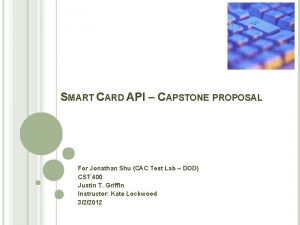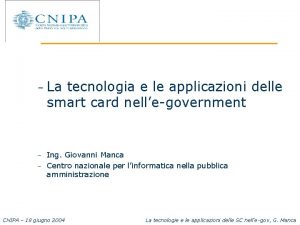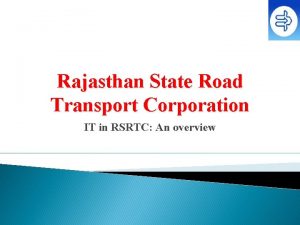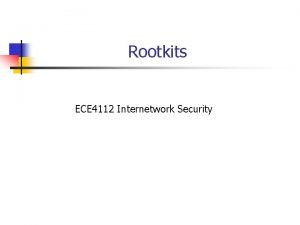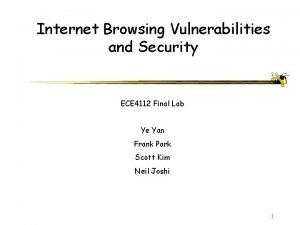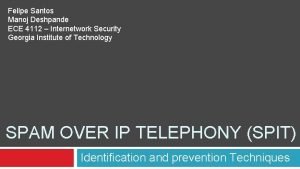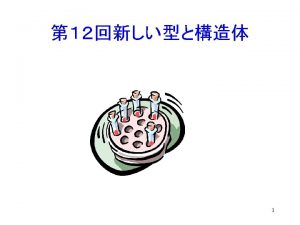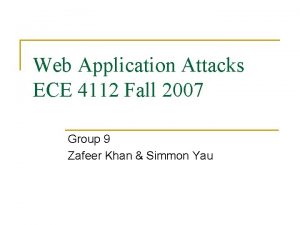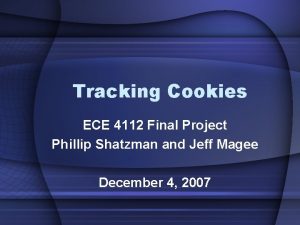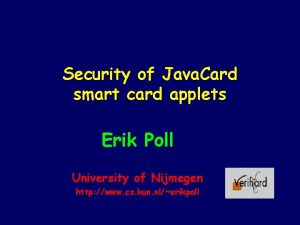ECE 4112 Smart Card Security Nicholas Dorsey Steven














- Slides: 14

ECE 4112 Smart Card Security Nicholas Dorsey Steven Hurst April 28 2005

Smart Cards and Networks • What do smart cards have to do with networks? • Does small = Secure? • The focus of our presentation is on the TI TMS 370 smart card that was previously used in pay TV system.

History Of Hacking Smart Cards • Sinception all US pay TV smart cards have been hacked • Early 1990’s smart cards made their way into pay TV systems, only to be hacked months later. • Each generation of smart card has had increased security features. • With each enhancement to security, more robust hacks have been developed. • Early hacks made use of “write-holes”. • More modern hacks make use of buffer overflow style attacks.

Methods of Attacking Smart Cards • Microprobing -Physically attack the microprocessor to facilitate a dump of its contents -Expensive -Requires skill and expensive equipment -Destructive • Glitching -Use a device to manipulate the clock speed and voltage to dump the contents of the card. -Devices are cheap (around $50) -May be destructive, and very time consuming • Buy trade secrets from developers of the technology

Glitching Attacks • Clock Bursts -Momentary, rapid increase in clock frequency -Causes instructions to be skipped, because execution routine does not have enough time to finish when the new clock cycle occurs. • Voltage Glitch -Momentary drop in voltage from about 4. 5 V to. 5 V -Causes instructions to be decoded incorrectly • These attacks can occur at the same time

Devices used to Attack Smart Cards • Called by several names (unloopers, glitchers, card readers) • Originally developed to repair corrupted EPROMs • In the early 1990 s Directv® sent an update to all the smart cards. This caused most hacked cards to enter into an infinite loop on startup. • The intention was to end smart card hacking for good by destroying the cards used by hackers. • The result was a hacking revolution • Two foreign groups emerged with devices to repair the cards called unloopers. Fast Eddie (Dean Love) and Vo. N (Chris Tarnovsky)

Devices Contd • The loop was similar to the following Code: 8000: jump $8005 …. 8005: jump $8000 …. . more code The unloopers applied a glitch at address 8005 causing the jump instruction to be skipped, or interpreted as a NOP.

Devices • The sale of these devices would fund satellite hacking for the next decade • As time went on the devices became more precise, and eventually became stand alone devices. • Today most glitchers use an Atmel AT 90 s 2313 AVR to control the clock and voltage glitches. • Newest generation of smart cards are not susceptible to clock and voltage glitches (directly).

How to go from Access to A Hack • Dump the card • Disassemble ROM and EPROM routines • Find code in EPROM that can be modified to give access to what you want • If pay TV hack, prevent hashing

Pay TV Hacks • Two types • Activation -cloning your neighbors card to watch TV for free • 3 Ms -one for all and all for one -modify code in the EPROM to enable all channels

What is Hashing • Some smart cards have routines that execute programs (hashes) from the data stream. • Hashes calculate a checksum of the EPROM and use this checksum as part of video decryption • New video packets are sent about every 8 sec • If the correct signature is not calculated, then the video cannot be decrypted • Anyone have any idea how to defeat a Hash?

What you will do in lab • Use a smart card programmer to passively get data from a smart card • Use glitching features to forcefully gain access to EPROM data • Use glitching features to repair corrupted Eprom data • Explore different utilities that do the above tasks. (Xtreme. HU and Win. Explorer)

News Flash Has the latest security card in use by Directv® been hacked?

References • www. interesting-devices. com • Excellent source for History and ongoing advances in smart card technology.
 Ashley dorsey
Ashley dorsey Simoniz distributors
Simoniz distributors Privatesecurity
Privatesecurity Book smart vs street smart
Book smart vs street smart One smart man he felt smart
One smart man he felt smart Interserf
Interserf Future smart investing in you answers
Future smart investing in you answers It's not how smart you are
It's not how smart you are What is the next letter? a z b y c x d
What is the next letter? a z b y c x d Street smart vs book smart quotes
Street smart vs book smart quotes One smart man he felt smart
One smart man he felt smart Smart card api
Smart card api Tecnologia smart card
Tecnologia smart card Rsrtc bus tracking
Rsrtc bus tracking Octoplus smart card driver
Octoplus smart card driver











